
Sir Cecil Herbert Edward Chubb, 1st Baronet (14 April 1876 – 22 September 1934), was the last private owner of Stonehenge prehistoric monument, Wiltshire, which he donated to the British government in 1918.

Sir Cecil Herbert Edward Chubb, 1st Baronet (14 April 1876 – 22 September 1934), was the last private owner of Stonehenge prehistoric monument, Wiltshire, which he donated to the British government in 1918.
Chubb was born in Shrewton, a village 4 miles (6.4 km) west of Stonehenge, the eldest son of Alfred and Mary Chubb. His father, "Fred", was the village saddler and harness maker, as was his father before him. Cecil attended the local village school and then the Bishop Wordsworth's School in Salisbury, where from the age of 14 he worked for a time as a student teacher.
Chubb met his future wife at a cricket game between his Bishop Wordsworth School and Fisherton House Asylum. He then attended Christ's College, Cambridge where he was awarded a double first in Science and Law, leaving with Master of Arts and Bachelor of Law degrees.
Chubb became a barrister and amassed a considerable fortune. [1]
In 1902 he married Mary Bella Alice Finch, whose uncle, Dr W. Corbin Finch, owned Fisherton House, which was a mental asylum (later the Old Manor Hospital, now Fountain Way). Five years after her uncle's death in 1905, the business and buildings were transferred to her. Following financial difficulties, a limited company was formed to run the hospital in 1924, and Sir Cecil became chairman. While he was in charge, the hospital became the largest private mental hospital in Europe. There is a plaque in the hospital commemorating his life and work.
Sir Cecil also served on Salisbury City Council, was a Justice of the Peace and became a successful racehorse owner and breeder of Shorthorn cattle. [2]
Stonehenge was one of several lots put up for auction in 1915 by Sir Cosmo Gordon Antrobus, soon after he had inherited the estate from his brother.[ citation needed ] Cecil Chubb's interest in the local area led to his attending the sale, with him bidding and purchasing Lot 15 on a whim for £6,600 (about £563,000/€664,000/$736,000 today), [3] as he wished to avoid the stones being acquired by someone overseas.
He gave Stonehenge to the nation on 26 October 1918. The deed of gift included the following conditions:
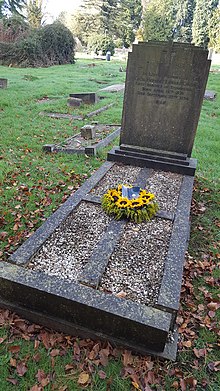
First that the public shall have free access to the premises hereby conveyed and every part thereof on the payment of such reasonable sum per head not exceeding one shilling for each visit and subject to such conditions as the Commissioners of Works in the exercise and execution of their statutory powers and duties may from time to time impose Secondly that the premises shall so far as possible be maintained in their present condition Thirdly that no building or erection other than a pay box similar to the Pay Box now standing on the premises shall be erected on any part of the premises within four hundred yards of The Milestone marked "Amesbury 2" on the northern frontage of the premises and Fourthly that the Commissioners of Works will at all times save harmless and keep indemnified the Donors and each of them their and each of their estates and effects from and against all proceedings costs claims and expenses on account of any breach or non-observance of the covenants by the Donors to the like or similar effect contained in the Conveyance of the premises to the Donors. [4]
Local residents are still entitled to free admission to Stonehenge because of a different agreement concerning the moving of a right of way. [5]
To mark his generosity he was made a baronet in 1919 by Lloyd George. [6] Chubb's arms feature a trilithon representing Stonehenge.
Chubb died of heart disease at his house (from 1930) in Bournemouth, Rothwell Dene, on 22 September 1934 aged 58, [7] leaving behind his wife, son John, who succeeded him, and daughter Mary. [8] [9]
A plaque commemorating his birth was erected in the late 1980s on the house in Shrewton where he was born. It was unveiled by his two surviving nephews. [10]

Salisbury is a cathedral city in Wiltshire, England with a population of 41,820, at the confluence of the rivers Avon, Nadder and Bourne. The city is approximately 20 miles from Southampton and 30 miles from Bath.

Amesbury is a town and civil parish in Wiltshire, England. It is known for the prehistoric monument of Stonehenge which is within the parish. The town is claimed to be the oldest occupied settlement in Great Britain, having been first settled around 8820 BC. The parish includes the hamlets of Ratfyn and West Amesbury, and part of Boscombe Down military airfield.

The Amesbury Archer is an early Bronze Age man whose grave was discovered during excavations at the site of a new housing development in Amesbury near Stonehenge. The grave was uncovered in May 2002. The man was middle aged when he died, estimated between 35 and 45, and is believed to date from about 2300 BC. He is nicknamed "the Archer" because of the many arrowheads buried with him. The grave contained more artefacts than any other early British Bronze Age burial, including the earliest known gold objects ever found in England. It was the first evidence of a very high status and wealth expressed in a burial from that time. Previously, Bronze Age society had been assumed not to have been particularly hierarchical.

Bishop Wordsworth's School is a Church of England boys' grammar school in Salisbury, Wiltshire for boys aged 11 to 18. The school is regularly amongst the top-performing schools in England, and in 2010 was the school with the best results in the English Baccalaureate. It was granted academy status in March 2011 and is an Additional Member of the Headmasters' and Headmistresses' Conference. It is within the grounds of Salisbury Cathedral, adjacent to the Cathedral School.

The Stonehenge Landscape is a property of The National Trust, located on Salisbury Plain in Wiltshire, England. The estate covers 2,100 acres (850 ha) surrounding the neolithic monument of Stonehenge, which is administered by English Heritage. Much of the land is designated open access by the Trust, including the fields immediately around Stonehenge and other fields that become available as part of the chalk grassland reversion project. Stonehenge itself is in the care of English Heritage, having been given to the nation in 1918 by Cecil and Mary Chubb, who had bought it three years previously from the Antrobus family.

Wylye is a village and civil parish on the River Wylye in Wiltshire, England. The village is about 9+1⁄2 miles (15 km) northwest of Salisbury and a similar distance southeast of Warminster.
Philip Alexander Grahame Russell, known as Wally Hope, was an experimental philosopher of the UK Underground and organiser of the Windsor Free Festival and the Stonehenge Free Festival.

This is a list of the sheriffs and high sheriffs of Wiltshire.
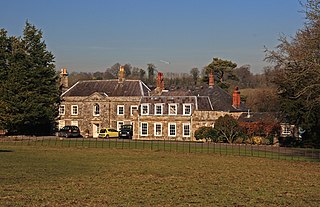
Bapton is a hamlet in Wiltshire, England, in the civil parish of Stockton. It lies south of the A36 and the River Wylye, on the minor road which follows the right bank of the Wylye, about 1 mile southeast of Stockton village and about 9 miles (14 km) southeast of Warminster.

Frederick Basil Chubb was an English and Irish political scientist, author and broadcaster.

Shrewton is a village and civil parish on Salisbury Plain in Wiltshire, England, around 6 miles (9.7 km) west of Amesbury and 14 miles (23 km) north of Salisbury. It lies on the A360 road between Stonehenge and Tilshead. It is close to the source of the River Till, which flows south to Stapleford.

Orcheston(OR-Chest-ton) is a civil parish and village in Wiltshire, England, lying on Salisbury Plain less than a mile north-west of neighbouring Shrewton. The present-day parish combines the two former parishes of Orcheston St Mary and Orcheston St George and includes the hamlet of Elston.
The Amesbury and Military Camp Light Railway was a branch line in Wiltshire, England, constructed under a light railway order dated 24 September 1898. It was opened for military traffic from Amesbury to the east-facing Newton Tony Junction on 1 October 1901. A west-facing junction, Amesbury Junction, where the branch burrowed under the main line, opened on 2 June 1902. The line closed in 1963.
John Alfred Lush was an English Liberal politician who sat in the House of Commons from 1868 to 1880.
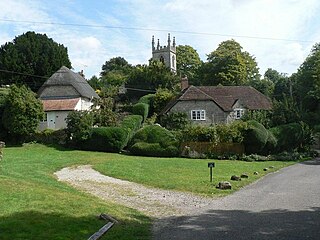
Fisherton de la Mere, also spelt Fisherton Delamere, is a small village and former civil parish, now in the parish of Wylye, on the River Wylye, Wiltshire, England. The village lies just off the A36, midway between Salisbury and Warminster, each about 10 miles (16 km) distant. The parish came to an end in 1934 and was divided between Wylye and Stockton, the latter gaining the hamlet of Bapton while the village of Fisherton de la Mere retained a separate identity within Wylye. In 1931 the parish had a population of 195.

The Old Manor Hospital was a psychiatric hospital in Salisbury, Wiltshire, England. It was established in the early 19th century as a private licensed house called Fisherton House or Fisherton House Asylum, which became the largest private madhouse in the United Kingdom. In 1924, following a change of proprietors, it was renamed Old Manor Hospital and in 1955 it was amalgamated into the National Health Service. From 1813 to 1955 it was owned and managed by members of the same family. The Old Manor Hospital closed in 2003 and was replaced by Fountain Way, a smaller, modern, psychiatric hospital on part of the same site. In 2014 the site was acquired by Quantum Group for development as a residential estate and the conversion of the main building to a hotel.
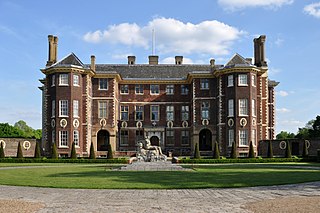
Sir Lyonel Felix Carteret Eugene Tollemache, 4th Baronet was an English landowner.
Adrian Green is a curator, and has been director of The Salisbury Museum in Wiltshire, England, since 2007.
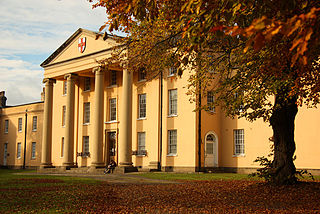
Richard Ingleman (1777–1838) was a surveyor and architect of Southwell in Nottinghamshire, England. Initially his architectural practice was based on the Southwell area, but he won widespread respect for his designs for the Southwell House of Correction (1807–8). This led to his gaining major commissions for prisons and mental hospitals, particularly in Wiltshire and at Oxford.
Sir Edmund Antrobus, 4th Baronet was a British army officer and a landowner in Wiltshire. His lands included the ancient monument of Stonehenge.